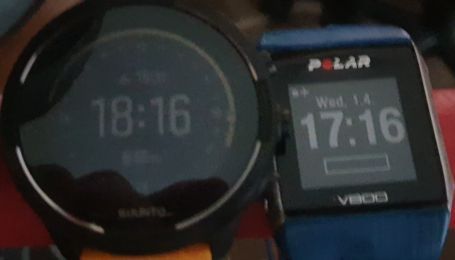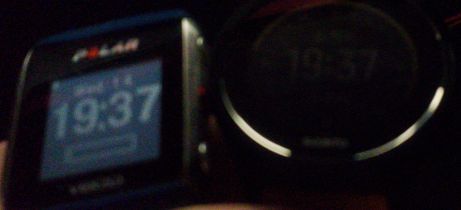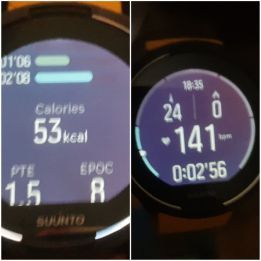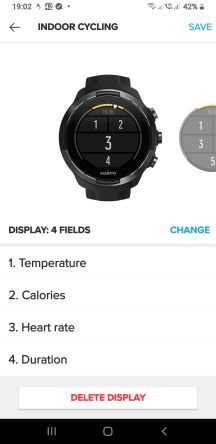S9B - nothing but problems, how can you praise this watch?!
-
@Dimitrios-Kanellopoulos said in S9B - nothing but problems, how can you praise this watch?!:
@Cuba1hr yeah keep in mind the Suunto calories report also BMR.
I think it’s higher even if you include BMR, even if you include prorated “passive calories”, i.e. sedentary calories that go over BMR but do not include actual activity like sitting and being lightly active.
Either that, or Suunto’s BMR is way more optimistic than it should be. You need more middle aged coach potatoes among your testers.
I’d offer myself but I’m not exactly middle aged yet, and thanks to Suunto, no longer a coach potato

-
@Brad_Olwin said in S9B - nothing but problems, how can you praise this watch?!:
I know that the step counter determination is different for the S3 vs the S9, but I do not know why.
I think for the same reason HR is more accurate on S3 and S5 vs S9 despite having practically the same Valencell sensor. The S9 is heavier and has higher profile, so more wobble throwing off accelerometer.
-
Of course I will listen my body, that was a joke.
Yes, I know. Also Polar does that, counts in BMR during exercise. 53 calories of those from training are from BMR by Polar. (I can see that in Activity nicely laid out).
I think there is no way to see that on Suunto. Only Active/TOTAL and also in exercise (logbook), but something is off.Those two (Exercise and activity) are the same at the moment on my watch. Almost, my active calories are exactly 1 cal higher than from my exercise. I wear the watch all the time. Weird:) I cannot find out how much of those are spent on BMR during the exercise because of those strange numbers. There is no way I spent only 1 extra active calorie beside the exercise in the entire day. Another glitch found:)
Polar has that clear in Activity:
Training
Activity
BMR
TOTAL
One thing I forgot to mention is that I finally tried GPS+BeiDou for a short walk (0.5km) and back (total 1km) few days ago, as two activities. Mixed feelings about that one, now it will take some time for me to repeat that and to get out of the house. I would like to compare it during couple of runs along the same roads (GPS only, vs + Beidou and vs + Galileo) for my final verdict and choice, but I will wait for some better times.
First one: it was OK and followed the road for the first 100m, then is all over the place for the next 400m. Path is “through” the buildings, in the middle of the building, all the way till the end.
Second one: The way back was much better, wouldn’t claim that it is better than GPS only, but at least it was away from the buildings, along the road most of the way.@NickK
Vo2 Max - in Polar 42 (via Fitness Test), HR MAX 203, same on both.I am not it the form currently. I am aware all those measurement should be some guidance, to compare with previous results on the same platform.
Suunto - don’t know because it was reset, and cannot go for a run. I have it from last run, about month ago - 34, but with OHR. -
@Cuba1hr said in S9B - nothing but problems, how can you praise this watch?!:
Vo2 Max - in Polar 42 (via Fitness Test), HR MAX 203, same on both.
Both yes, but only Polar takes VO2 Max into account for load and recovery estimates, and 42 on Fitness Test would definitely result in extra recovery hours heaped on top for a good measure. Also, Polar should be adjusting their numbers over time based on your workout history.
Suunto - don’t know because it was reset, and cannot go for a run. I have it from last run, about month ago - 34, but with OHR.
As long as OHR doesn’t show cadence locks and the likes, I’d trust that lower number way more than Polar’s. Their Fitness Test and even Running Index tend to significantly overestimate VO2 Max. Fitness Test is actually a complete statistical voodoo that’s been shown to have little if anything in common with the actual observed VO2 Max values.
I know I said it already, but… Just like steps, calories, and recovery hours, the VO2 Max from a watch, any watch, is another mostly meaningless number. You want it go up, sure! But if I were you, I’d be paying closer attention to improvements in pace, average heart rate, and cardiac drift than any these benchmarks. At the end of the day, there’s more to fitness than just VO2 Max even if you subscribe to a purely mechanistic view of exercise.
-
@NickK
Yes, I agree with what you said. I haven’t been using Polar at all except for that comparison between watches (2 exercises) and Fitness test week or two ago. I have an earlier results of 51 more than a year ago. There is no VO2 Max under every activities on Polar side, except for those “manual” fitness tests and you can see the progress from date to date. I really dig all of their graphs on Flow, which I miss, but there is a solution for something close enough to that on QS (or even better) thanks to Dimitrios.One other thing that they have and Suunto doesn’t are estimated fat calories burned percentage which is interesting, but I guess S9 is for “more pro” athletes who don’t need those things, because of low number of calories from fat they have:). I don’t know if the S3 shows that, probably not.:)
-
@Cuba1hr the burner app you mean right ?
-
@Dimitrios-Kanellopoulos
I mean, that is not in the mobile app (of both manufacturers), but there is in the Flow on the web, if you are talking about that second part.This:
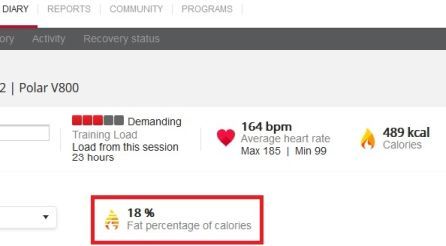
I don’t know if that is somewhere available on QS, under saved activity? If not - a suggestion.
-
@Cuba1hr I am looking to those metrics to be honest but from QS it will be hard. I am sure Suunto has looked into this, but I don’t know if there is a patent with polar about this.
Some time in the past that I had looked for QS todo that Polar has the patent over a paper that was released. On a personal level I gave up, because I don’t want any Giant to come over me
-
Yes, don’t bother then. Thank you anyway.
-
@Cuba1hr @Dimitrios-Kanellopoulos I think Polar simply looks at your heart rate distribution and uses established equations on fat/carbs as primary fuel source based on intensity.
The fun part is: if you rely on default heart rate zones set by Polar or yet another age-based formula, this number is probably off, and by a lot. You need to be below your aerobic threshold to use fat as a primary fuel and in a steady state activity. Go harder than necessary, or in an interval stop-go fashion, and you’ll be relying on alactic or anaerobic pathways.
Check out Uphill Athlete. They have multiple ways to test for aerobic and anaerobic thresholds. Once you have these, set your Suunto 9 heart rate zones based on their recommendation and do long runs or bike sessions (working up to 90-120 minutes a pop, longer sessions being really good at forcing your body to rely on fats and conserve carbs) below your aerobic threshold. That would build up an aerobic base and force all sorts of metabolism enhancing adaptations.
Between consistent exercise and clean, reasonable diet, you’d be in decent shape in no time.
